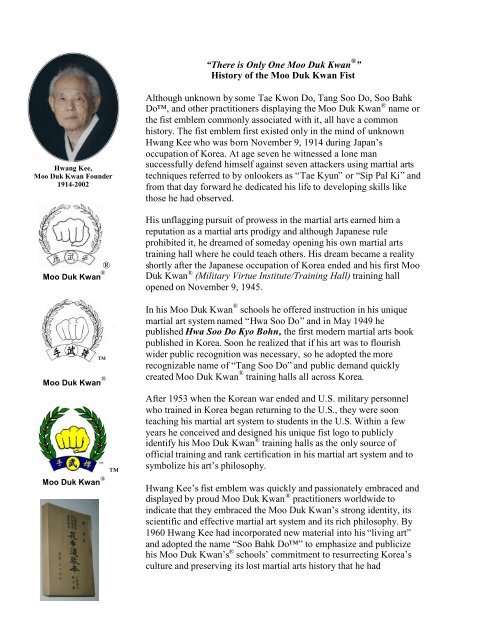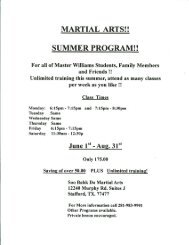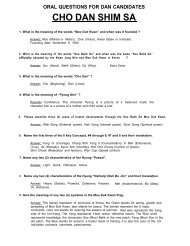There is Only One Moo Duk Kwan - Soo Bahk Do Moo Duk Kwan
There is Only One Moo Duk Kwan - Soo Bahk Do Moo Duk Kwan
There is Only One Moo Duk Kwan - Soo Bahk Do Moo Duk Kwan
You also want an ePaper? Increase the reach of your titles
YUMPU automatically turns print PDFs into web optimized ePapers that Google loves.
“<strong>There</strong> <strong>is</strong> <strong>Only</strong> <strong>One</strong> <strong>Moo</strong> <strong>Duk</strong> <strong>Kwan</strong> ® ”<br />
H<strong>is</strong>tory of the <strong>Moo</strong> <strong>Duk</strong> <strong>Kwan</strong> F<strong>is</strong>t<br />
Hwang Kee,<br />
<strong>Moo</strong> <strong>Duk</strong> <strong>Kwan</strong> Founder<br />
1914-2002<br />
®<br />
Although unknown by some Tae Kwon <strong>Do</strong>, Tang <strong>Soo</strong> <strong>Do</strong>, <strong>Soo</strong> <strong>Bahk</strong><br />
<strong>Do</strong>, and other practitioners d<strong>is</strong>playing the <strong>Moo</strong> <strong>Duk</strong> <strong>Kwan</strong> ® name or<br />
the f<strong>is</strong>t emblem commonly associated with it, all have a common<br />
h<strong>is</strong>tory. The f<strong>is</strong>t emblem first ex<strong>is</strong>ted only in the mind of unknown<br />
Hwang Kee who was born November 9, 1914 during Japan’s<br />
occupation of Korea. At age seven he witnessed a lone man<br />
successfully defend himself against seven attackers using martial arts<br />
techniques referred to by onlookers as “Tae Kyun” or “Sip Pal Ki” and<br />
from that day forward he dedicated h<strong>is</strong> life to developing skills like<br />
those he had observed.<br />
H<strong>is</strong> unflagging pursuit of prowess in the martial arts earned him a<br />
reputation as a martial arts prodigy and although Japanese rule<br />
prohibited it, he dreamed of someday opening h<strong>is</strong> own martial arts<br />
training hall where he could teach others. H<strong>is</strong> dream became a reality<br />
shortly after the Japanese occupation of Korea ended and h<strong>is</strong> first <strong>Moo</strong><br />
<strong>Duk</strong> <strong>Kwan</strong> ® (Military Virtue Institute/Training Hall) training hall<br />
opened on November 9, 1945.<br />
<strong>Moo</strong> <strong>Duk</strong> <strong>Kwan</strong> ® <br />
<strong>Moo</strong> <strong>Duk</strong> <strong>Kwan</strong> ® <br />
<strong>Moo</strong> <strong>Duk</strong> <strong>Kwan</strong> ®<br />
In h<strong>is</strong> <strong>Moo</strong> <strong>Duk</strong> <strong>Kwan</strong> ® schools he offered instruction in h<strong>is</strong> unique<br />
martial art system named “Hwa <strong>Soo</strong> <strong>Do</strong>” and in May 1949 he<br />
publ<strong>is</strong>hed Hwa <strong>Soo</strong> <strong>Do</strong> Kyo Bohn, the first modern martial arts book<br />
publ<strong>is</strong>hed in Korea. <strong>Soo</strong>n he realized that if h<strong>is</strong> art was to flour<strong>is</strong>h<br />
wider public recognition was necessary, so he adopted the more<br />
recognizable name of “Tang <strong>Soo</strong> <strong>Do</strong>” and public demand quickly<br />
created <strong>Moo</strong> <strong>Duk</strong> <strong>Kwan</strong> ® training halls all across Korea.<br />
After 1953 when the Korean war ended and U.S. military personnel<br />
who trained in Korea began returning to the U.S., they were soon<br />
teaching h<strong>is</strong> martial art system to students in the U.S. Within a few<br />
years he conceived and designed h<strong>is</strong> unique f<strong>is</strong>t logo to publicly<br />
identify h<strong>is</strong> <strong>Moo</strong> <strong>Duk</strong> <strong>Kwan</strong> ® training halls as the only source of<br />
official training and rank certification in h<strong>is</strong> martial art system and to<br />
symbolize h<strong>is</strong> art’s philosophy.<br />
Hwang Kee’s f<strong>is</strong>t emblem was quickly and passionately embraced and<br />
d<strong>is</strong>played by proud <strong>Moo</strong> <strong>Duk</strong> <strong>Kwan</strong> ® practitioners worldwide to<br />
indicate that they embraced the <strong>Moo</strong> <strong>Duk</strong> <strong>Kwan</strong>’s strong identity, its<br />
scientific and effective martial art system and its rich philosophy. By<br />
1960 Hwang Kee had incorporated new material into h<strong>is</strong> “living art”<br />
and adopted the name “<strong>Soo</strong> <strong>Bahk</strong> <strong>Do</strong>” to emphasize and publicize<br />
h<strong>is</strong> <strong>Moo</strong> <strong>Duk</strong> <strong>Kwan</strong>’s ® schools’ commitment to resurrecting Korea’s<br />
culture and preserving its lost martial arts h<strong>is</strong>tory that he had
d<strong>is</strong>covered in the text “<strong>Moo</strong> Yei <strong>Do</strong> Bo Tong Ji.” H<strong>is</strong> f<strong>is</strong>t emblem<br />
soon became deeply embedded in Korean practitioner’s hearts and<br />
minds as a symbol of Korea’s pride in its new emerging identity as an<br />
independent nation and in a culture that was finally, truly Korean.<br />
The <strong>Moo</strong> <strong>Duk</strong> <strong>Kwan</strong> ® schools’ tremendous success and widespread<br />
public appeal attracted government interest in the martial arts and in<br />
1964 the Korean Tae Kwon <strong>Do</strong> Association was formed to unite all<br />
Korea martial art<strong>is</strong>ts under one name. Under tremendous political<br />
pressure, Hwang Kee resolutely ins<strong>is</strong>ted upon preserving the unique<br />
identity of the <strong>Moo</strong> <strong>Duk</strong> <strong>Kwan</strong> ® schools and h<strong>is</strong> martial art system and<br />
he successfully fought a legal battle to maintain the right to do so all<br />
the way to the Korean supreme court in June1966. Unfortunately, by<br />
th<strong>is</strong> time the fracturing of the <strong>Moo</strong> <strong>Duk</strong> <strong>Kwan</strong>’s ® members was well<br />
underway due to mounting political pressures and competing loyalties;<br />
but interestingly, almost all who forfeited their ties with the <strong>Moo</strong> <strong>Duk</strong><br />
<strong>Kwan</strong> ® school and its founder steadfastly continued their use and<br />
proud d<strong>is</strong>play of h<strong>is</strong> f<strong>is</strong>t emblem and the <strong>Moo</strong> <strong>Duk</strong> <strong>Kwan</strong> ® name. Even<br />
as many succumbed to political pressures and adopted the Tae Kwon<br />
<strong>Do</strong> name, they refused to relinqu<strong>is</strong>h their use of Hwang Kee’s f<strong>is</strong>t<br />
emblem due to their strong emotional investment in, and attachment to,<br />
all that it symbolizes.<br />
In 1987 Hwang Kee trademarked h<strong>is</strong> f<strong>is</strong>t emblem in order to curtail<br />
public m<strong>is</strong>representation by parties who were no longer affiliated with<br />
h<strong>is</strong> <strong>Moo</strong> <strong>Duk</strong> <strong>Kwan</strong> ® schools. Even today, some practitioners still<br />
d<strong>is</strong>play Hwang Kee’s f<strong>is</strong>t emblem without knowledge of its origin, its<br />
meaning, its rich h<strong>is</strong>tory and without awareness that only current<br />
members of the <strong>Moo</strong> <strong>Duk</strong> <strong>Kwan</strong> ® school are legally authorized to<br />
d<strong>is</strong>play it in honor of Hwang Kee’s legacy to the world. H<strong>is</strong> f<strong>is</strong>t<br />
emblem has come to represent the spirit of an undefeatable warrior and<br />
a dedicated scholar. That which it represents has proven to be far more<br />
resilient and powerful than all the forces that have besieged it since its<br />
inception and Hwang Kee’s heart, spirit and legacy truly live on in the<br />
f<strong>is</strong>t image that he created to represent the essence of h<strong>is</strong> life’s work.<br />
All who d<strong>is</strong>play it are the children of h<strong>is</strong> life.<br />
Phil Duncan<br />
05/2006<br />
Based on information from the text, “H<strong>is</strong>tory of the <strong>Moo</strong> <strong>Duk</strong> <strong>Kwan</strong>”<br />
by Hwang Kee and H.C. Hwang.<br />
<strong>Moo</strong> <strong>Duk</strong> <strong>Kwan</strong> ® and the f<strong>is</strong>t emblem are reg<strong>is</strong>tered trademarks of the U.S. <strong>Soo</strong> <strong>Bahk</strong> <strong>Do</strong> <strong>Moo</strong><br />
<strong>Duk</strong> <strong>Kwan</strong> Federation and cannot be used without written perm<strong>is</strong>sion.





